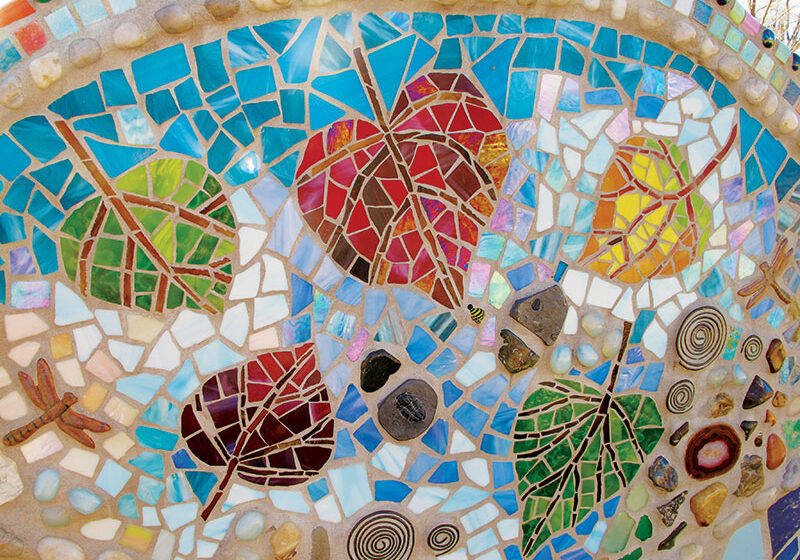Organizing art and pictures on a wall is harder than it looks, and taking time to talk with an expert can offer valuable knowledge and spark ideas. Whether displaying art, photos, maps or keepsakes, a professional framer can lend a helping hand regarding the best ways to make items look good, and can also offer tips on how to preserve them for years to come.
The crew at Chico Paper Company have all been with the company for over a decade, and are ready to share their valuable knowledge with customers. Owner Jana Strong says her staff has seen and worked with a wide variety of materials. “We have a very skilled group of artists that work here… everyone has an art degree, she says.
The Chico Paper Company staff can look at a piece and know how to handle it, including how to stretch a canvas properly and what materials go well together. They want their customers to have long-term protection for cherished photos and art, offering heirloom-quality frames that stand the test of time, along with museum glass and acid-free matting that’s so important to preserving art and photos from deterioration.
At Aaron Brothers, located in Chico and Redding, all team members are design and frame certified through an in-house certification process. The staff knows the techniques necessary to protect art, as well as how to help customers with the design process for framing items to enhance the beauty of art.
Theresa Barry, Aaron Brothers store manager in Chico, says it is not the type of frame that preserves artwork, but how the framing is done and the type of materials used to do the framing. The most important aspects are the use of archival materials such as lignin-free archival mats to prevent discoloration/deterioration of the artwork, archival mounting boards, and UV protective glass to prevent fading.
“Many people believe that if the artwork is hanging where no sunlight will ever shine on it that UV glass is not necessary,” Barry says. “While keeping your art out of any direct sunlight is very important, many people do not realize that any light can fade artwork, including indoor lighting.”
Lesa Michel, owner of The Gallery in Mt. Shasta, offers both glass and acrylic for customer framing needs. Some of her customers prefer one over the other, and she believes there is a time and purpose for both options. In general, glass is less likely to scratch, but acrylic won’t break as easily. How an item is secured in a frame is important to its preservation – mats made from 100 percent cotton rag or alpha-cellulose are the best choices, advises Michel.
When it comes to frames, basic black with white mats remains a popular choice. New design trends revolve around creating a three-dimensional look using wall brackets to “pop” frames off a wall, or incorporating shelves or objects. A three-dimensional look can also be created by using empty frames (called open wood) and overlapping them, or by using them to frame an object on a wall incorporating color and texture is becoming a trend as well.
Barry advises that to create a unique but cohesive look, choose an element that ties all the frames together (color, texture or theme) and build the wall from the center out, focusing on balancing, but not necessarily mirroring.
Michel has similar ideas about wall creations. Matching or coordinating with a predominant color in the piece of art is a good idea, but the style of a frame should always flatter the art it surrounds. For example, an ornate frame may work well with abstract art to help it work in a classic space, or a fresh look for traditional art can be achieved when paired with a soft contemporary frame style.
According to Michel, a common practice, known as stacking is to combine more than one frame molding to make a single frame. Stacking frame moldings allows people to mix colors or styles to coordinate with art. People can also use a float, a minimalist frame option used when framing art on canvas. The painting drops into the front of the frame so none of its front surface is covered.
[sws_grey_box box_size=”593″]
The North State offers competent resources for your framing needs.
For more ideas, visit the stores mentioned at these locations:
Aaron Brothers
http://www.aaronbrothers.com
Chico: 2015 Forest Ave., Ste B.
(530) 894-2198.
Redding: 917 Dana Dr. Ste C.
(530) 223-0992.
Chico Paper Company
http://www.chicopapercompany.com
345 Broadway, Chico.
(530) 891-0900.
The Gallery in Mount Shasta
http://www.thegalleryinmtshasta.com
201-A North Mt. Shasta Blvd.
(530) 926-2334.
[/sws_grey_box]
Posted in: Art & Music, Community
Comment Policy: All viewpoints are welcome, but comments should remain relevant. Personal attacks, profanity, and aggressive behavior are not allowed. No spam, advertising, or promoting of products/services. Please, only use your real name and limit the amount of links submitted in your comment.
Comments
Leave a Reply
You Might Also Like...

How to Enjoy the Benefits of Nature Inside, When You Can’t Get Outside
Spending time in nature is so beneficial to our health and well-being. It calms us, reducing feelings of stress, anxiety and anger. It has also been shown to improve focus […]

In Love With Texture & Tiles
Artist Colleen Barry’s house looks like no other on the block. Light blue with globe-sized mosaic finials resting atop a matching cobalt blue wrought iron gate, its design is whimsical, […]

Tools of the Kitchen Trade (But Really Just for the Fun of It!)
The kitchen is one of my favorite places to be, and I believe I’m truly lucky to feel that way. There was a time when I was convinced that cooking […]

Essential Elements for a Water-Smart Family in a Dry Year
Splashing in the pool or dipping your toes into a flowing creek is excellent for a hot North State summer cool down. As temperatures rise, water usage spikes with sprinklers […]



Art On Canvas says
I agree about multiple stackings for a frame. It’s perfect and I think that’s the only way to do it, and I’m suprised it’s not considered more often. Although I’ve done it myself for what seems like forever, I rarely encounter it as a regular practice.